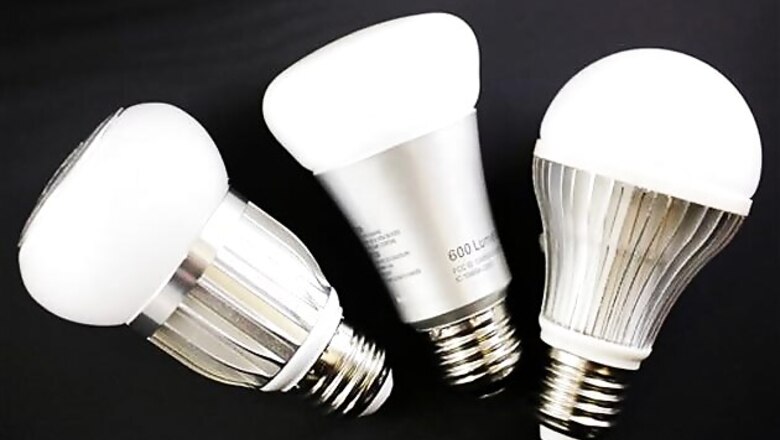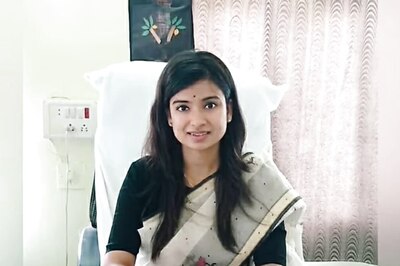
views
New York: LED bulbs seem to be the future of home lighting: They save electricity, they're durable and they don't contain mercury like compact fluorescents. But having them produce white light like any old light bulb is like using a computer as a doorstop.
That's because each LED, or light-emitting diode, is a small chip, the product of the same sort of manufacturing process that spawned the digital revolution. The chips are backed up by more electronics in the stem of the bulb. These bulbs are smart, or at least they can be if we make them that way.
Philips, the world's largest maker of LED lighting, does make them that way. The company has produced the first kit of LED bulbs whose colour and brightness can be wirelessly controlled from your iPhone. I tested the Philips bulbs and, in descending order of "smarts," I tried out some GreenWave Reality bulbs whose brightness can be controlled by an app. I also looked at a cheap off-brand colour-changing bulb that comes with a remote control.
Why would you want to control your light bulbs from your phone? I haven't really found a good answer yet. On their own, these bulbs aren't a big deal. Few people will pony up $200 for the Philips kit with three smart bulbs. But these products are still interesting because they point the way to the future of lighting. Remember: The first Apple computer was a niche product, too -and look where that went.
Each Philips bulb produces light equivalent to a 50-watt incandescent bulb. Additional bulbs cost $59 each. That compares with slightly brighter, non-smart, white-light Philips LED bulbs that cost $25 each.
The Hue bulbs cost more, Philips says, because there are five unique and expensive lime-green LEDs in each bulb, balanced by four red-orange ones and two blue ones. Together, these LEDs produce a range of colors, including a nice span of "whites," from warm to cold.
In the future, the price difference between color-mixing LEDs and regular ones will shrink, and perhaps vanish. Adding color and wireless controls to bulbs will cost very little, so we might as well get used to it.
In fact, I found a cheaper alternative to the Hue: an $18 bulb of the TorchStar brand. Amazon.com sells a bunch of similar ones under different names. This bulb doesn't talk to your phone. Instead, it comes with a small remote that lets you pick from 16 colours. Unfortunately, the "white" color is a nasty bluish shade, reminiscent of a bad fluorescent tube. It's also a lot dimmer than the Hue.
On the plus side, the TorchStar produces more vivid, saturated colours than the Hue. To produce a good white, the Hue sacrificed the ability to produce really deep colors.
I also found the remote on the TorchStar pretty friendly. Do I really want to whip out my iPhone or iPad and fire up the Hue app every time I want to adjust the lighting? In fact, I was tempted to attach the remote to the wall like a light switch - there's something to be said for those old wall switches.
Once you have it up, the free Hue app is entertaining. One of the ways you can change colours is to pick a photo, then point to the hues you want the lights to replicate. The app sends your commands to your Wi-Fi router. The router, in turn, tells the Hue base station (a small box included in the $200 kit) attached to it to send signals to the bulbs using a different wireless technology, known as Zigbee. Philips says the signal can reach nearly 100 feet (30 metres). But it can travel even farther if you have your bulbs strung out, because each bulb will relay the signal to others that can't "hear" the base station directly. So these bulbs are "smart" enough to talk to each other.
The "smarts" doesn't go all that far, though.
You can set a timer that's supposed to fade the light down slowly - a nice touch if you're trying to get a kid to sleep - but it didn't work for me. The light just cut out at the designated time, with no fade.
The base station is capable of connecting to the Internet, so you can control your lights away from the home. Some wags have created apps that turn the bulbs into disco lights that change colour in response to music they pick up from your phone's microphone.
But this is just the beginning of what an Internet-connected light should be able to do. In theory, you could key a light to the changing colours of daylight, or to warn you if there's likely to be rain today by changing to a green shade. The Hue doesn't do any of that, yet. Changing the colour is a manual process, even though it's mediated by a smartphone.
I tried a third "smart" lighting kit, from GreenWave Reality. This one contains two bulbs, a remote and a wireless base station. The bulbs can be dimmed from an iPhone app, but won't change colour. It's nice to have the remote as a backup to the app, but the overall usefulness of the kit was low.
GreenWave Reality, the startup behind it, wants to sell it through utility companies, for about $200. I can understand utilities wanting to push LEDs, but dimming just isn't very effective in saving energy. The big power savings, about 80 per cent, comes from switching from incandescent to LED or compact-fluorescent bulbs. Cutting the power use of an LED in half by dimming only yields savings of another 6 per cent or so. Besides, the GreenWave bulbs flicker when turned down.
The Hue, TorchStar and GreenWave bulbs co-existed in our house for a few months. What happened? Well, after initially fooling around with them, we forgot about controlling the Hue and GreenWave bulbs and just left them on full-blast white-light mode. We just didn't have enough reason to keep fiddling with them. My kids had a lot of fun with the TorchStar bulb and its remote in the beginning, but it's now mostly shining a calming purple as the night light in my daughter's room. The Hue bulbs could have fulfilled that role nicely too, except for one thing: if you turn them off with the wall switch, they're back in white-light mode the next time you turn them on. They don't "remember" their colour.
The underlying problem was that these "smart" lights forced us to do quite a bit of thinking and controlling. They relied on us for much of the "smarts," and we just couldn't be bothered.
Maybe, one day, we can get lights that will do what we want without being told, like dimming the lights when the mood is right. You do the thinking, bulbs, and let us be dumb.




















Comments
0 comment